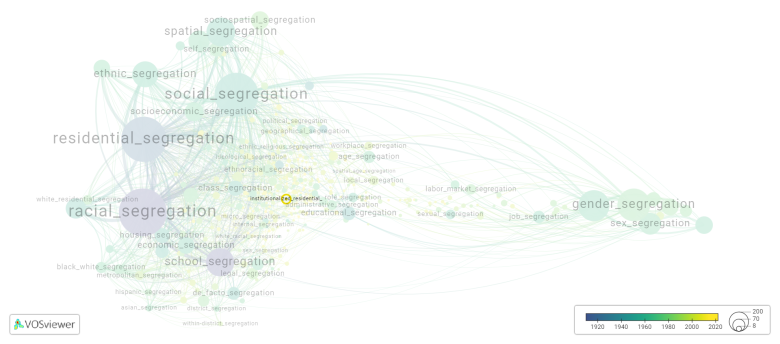Institutionalized residential segregation: Difference between revisions
(Creating page) |
(Creating page) |
||
| (10 intermediate revisions by the same user not shown) | |||
| Line 1: | Line 1: | ||
===== Date and country of first publication<ref>Date and country of first publication as informed by the Scopus database (December 2023).</ref>===== | |||
2021<br> | 2021<br> | ||
United States | |||
===== Definition ===== | |||
Institutionalized residential segregation refers to the practice of creating and maintaining separate residential areas for different racial or ethnic groups through policies, laws, and practices implemented by government bodies and other institutions. This form of segregation can be seen in practices like redlining, which denied housing opportunities to minority groups, or the creation of racially restrictive covenants that prevented non-white individuals from buying or renting properties in certain neighborhoods. | Institutionalized residential segregation refers to the practice of creating and maintaining separate residential areas for different racial or ethnic groups through policies, laws, and practices implemented by government bodies and other institutions. This form of segregation can be seen in practices like redlining, which denied housing opportunities to minority groups, or the creation of racially restrictive covenants that prevented non-white individuals from buying or renting properties in certain neighborhoods. | ||
| Line 8: | Line 10: | ||
Efforts to address institutionalized residential segregation typically involve policy changes, community organizing, and advocacy to dismantle discriminatory practices and promote fair and inclusive housing opportunities for all individuals. | Efforts to address institutionalized residential segregation typically involve policy changes, community organizing, and advocacy to dismantle discriminatory practices and promote fair and inclusive housing opportunities for all individuals. | ||
==See also== | ==See also== | ||
==Related segregation forms== | |||
Institutionalized residential segregation is frequently discussed in the literature with the following segregation forms: | |||
[[racial segregation]] | |||
[[File:institutionalized_residential_segregation.png|780x780px]] | |||
This visualization is based on the study [[Segregation_Wiki:About| The Multidisciplinary Landscape of Segregation Research]]. | |||
For the complete network of interrelated segregation forms, please refer to: | |||
* [https://tinyurl.com/2235lkhw First year of publication] | |||
* [https://tinyurl.com/2d8wg5n3 Louvain clusters] | |||
* [https://tinyurl.com/223udk5r Betweenness centrality] | |||
* [https://tinyurl.com/244d8unz Disciplines in which segregation forms first emerged (Scopus database).] | |||
==References== | ==References== | ||
== | ==Notes== | ||
<references /> | |||
{{NoteAI}} | |||
==Institutionalized residential segregation appears in the following literature== | |||
Brown E.M.L. (2021) | Brown E.M.L. (2021). Why Black Homeowners are More Likely to be Caribbean American than African American in New York: A Theory of How Early West Indian Migrants Broke Racial Cartels in Housing. ''American Journal of Legal History'', ''61''(1), 3-36. Oxford University Press.https://doi.org/10.1093/ajlh/njaa033 | ||
Latest revision as of 07:17, 16 October 2024
Date and country of first publication[1][edit | edit source]
2021
United States
Definition[edit | edit source]
Institutionalized residential segregation refers to the practice of creating and maintaining separate residential areas for different racial or ethnic groups through policies, laws, and practices implemented by government bodies and other institutions. This form of segregation can be seen in practices like redlining, which denied housing opportunities to minority groups, or the creation of racially restrictive covenants that prevented non-white individuals from buying or renting properties in certain neighborhoods.
Institutionalized residential segregation has had significant and lasting impacts on marginalized communities, leading to unequal access to opportunities, resources, and quality of life. It has also contributed to the persistence of racial disparities in areas such as education, income, and health outcomes.
Efforts to address institutionalized residential segregation typically involve policy changes, community organizing, and advocacy to dismantle discriminatory practices and promote fair and inclusive housing opportunities for all individuals.
See also[edit | edit source]
Related segregation forms[edit | edit source]
Institutionalized residential segregation is frequently discussed in the literature with the following segregation forms:
This visualization is based on the study The Multidisciplinary Landscape of Segregation Research.
For the complete network of interrelated segregation forms, please refer to:
References[edit | edit source]
Notes[edit | edit source]
- ↑ Date and country of first publication as informed by the Scopus database (December 2023).
At its current state, this definition has been generated by a Large Language Model (LLM) so far without review by an independent researcher or a member of the curating team of segregation experts that keep the Segregation Wiki online. While we strive for accuracy, we cannot guarantee its reliability, completeness and timeliness. Please use this content with caution and verify information as needed. Also, feel free to improve on the definition as you see fit, including the use of references and other informational resources. We value your input in enhancing the quality and accuracy of the definitions of segregation forms collectively offered in the Segregation Wiki ©.
Institutionalized residential segregation appears in the following literature[edit | edit source]
Brown E.M.L. (2021). Why Black Homeowners are More Likely to be Caribbean American than African American in New York: A Theory of How Early West Indian Migrants Broke Racial Cartels in Housing. American Journal of Legal History, 61(1), 3-36. Oxford University Press.https://doi.org/10.1093/ajlh/njaa033

